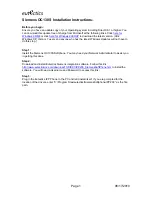
Page 23 | AlliedWare Plus™ OS: Overview of QoS
Queue shaping—queue sets, RED, and tail-drop
A
queue set
defines how the switch determines what traffic to drop when a port’s queues
become congested. The queue set applies to one or more of the port’s queues, and specifies
the queue size thresholds at which the port starts to drop traffic from that queue.
You can use up to four different queue sets across the switch.There are two steps involved in
configuring queue sets:
1.
configure the queue set parameters
2.
apply the queue set to the desired port
There are two options for how each queue set drops excess traffic:
z
random-detect mode
z
tail-drop mode
In random-detect mode, the switch uses RED to shape queues. In tail-drop mode, the switch
simply drops excess traffic from the end of queues. Both modes are color-aware—you can
configure different thresholds for different bandwidth classes.
The following sections describe how to configure random-detect and tail-drop mode, but
first you need to consider the default settings.
Default
settings
If you do not configure queue shaping:
z
1
0/
1
00/
1
000M ports use tail-drop mode with settings from queue set
1
(which gets a
default description of “
1
G Defaults”)
z
1
0G ports use tail-drop mode with settings from queue set 2 if there are also
1
G ports
present, or otherwise settings from queue set
1
(the used queue set gets a default
description of “
1
0G Defaults”)
Don’t customise the default queue sets unless you want to change the settings on
all ports of that type.
You can check which are the default queue sets and their current settings, by using the
command:
awplus#show mls qos queue-set
The following table shows the values for the default queue set for each port speed. These
settings apply to each egress queue and each bandwidth class—green, yellow and red traffic
all have the same values. The unused queue sets are empty, so all their values are 0.
Port speed
Setting
Value
1
G
Minimum threshold
1
00 KB
Maximum threshold
1
25 KB
Drop probability
50%
Averaging factor
9
















































